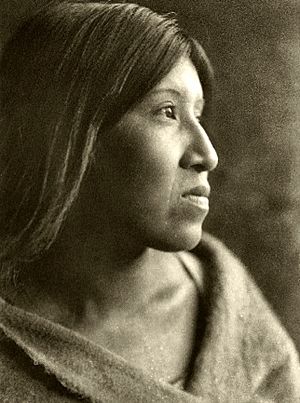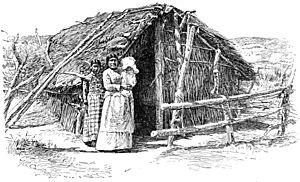Saahatpa, California facts for kids
Quick facts for kids Saahatpa, California |
|
|---|---|
| Lua error in Module:Location_map at line 420: attempt to index field 'wikibase' (a nil value). | |
| Location | Saahatpa, California |
| Built | 1845 |
| Designated | August 17, 1960 |
| Reference no. | 749 |

Saahatpa was an old village where the Cahuilla people lived in Riverside County, California. It was home to a group of Cahuilla people, led by Chief Juan Antonio, from 1851 to 1863. The village was in a valley that branched off from San Timoteo Canyon. Today, you can find the spot marked as California Historical Landmark #749. It's near Calimesa, California, by the old Brookside Rest Area on Interstate 10.
The History of Saahatpa Village
In 1845, Chief Juan Antonio and his Mountain Cahuilla people lived in a place called Politana. Their job was to protect the horses and cattle of Rancho San Bernardino from thieves and other groups from the desert and mountains.
They stayed there until 1851. At that time, a group of Americans, known as the Irving Gang, attacked the Rancho. They claimed they were getting revenge for some killings in the Cajon Pass. Chief Juan Antonio and his men had permission from the local judge to act. They chased the gang into San Timoteo Canyon. There, they surrounded and defeated the gang.
Many local Americans misunderstood this event. They thought it was an uprising by Native Americans against them. A group of soldiers from San Diego County, led by Joshua Bean, was sent to stop this supposed uprising. However, Judge Hayes looked into what happened. He found that Chief Juan Antonio's actions were legal and justified.
Even so, some local Americans were still upset about the incident. Because of this, Chief Juan Antonio decided to move his people. They moved away from the white settlements in the valley to Saahatpa.
Life and Challenges at Saahatpa
Chief Juan Antonio and his people lived peacefully at Saahatpa until the winter of 1862–1863. During this time, a terrible sickness called smallpox spread across Southern California. It caused many people to get very sick and die. Native American communities were hit especially hard because they had little protection against the disease.
Many Cahuilla people, including Chief Juan Antonio himself, died from smallpox. This disaster greatly reduced their numbers. They went from being the main group in their own land to a much smaller one. After this sad event, Chief Juan Antonio was buried at Saahatpa. The village was then left empty.
In 1956, a team of archaeologists found Chief Juan Antonio's body at Saahatpa. They knew it was him because of his special military shoulder decorations, called epaulets. He was later reburied with special honors, like a soldier.
The Saahatpa Historical Marker
There is a special marker at the Saahatpa site that tells its story. It says:
- NO. 749 SAAHATPA - Chief Juan Antonio and his band of Cahuilla Indians helped white settlers in the San Bernardino area defend their property and livestock against outlaws during the 1840s and 1850s. In late 1851, Juan Antonio, his warriors and their families, settled at nearby Saahatpa. During the winter of 1862-63, a smallpox epidemic swept through Southern California killing many Native Americans, including Juan Antonio. Cahuilla tradition asserts that the U.S. Government sent Army blankets that were contaminated with smallpox. After this disaster, Saahatpa was abandoned.
The marker has been difficult to reach since about 2005. The Brookside Rest Area, where it is located, was closed. This happened because the well that provided water dried up. The amount of water underground became too low due to a long period of dry weather. Later, money problems also made it hard to find a new water source. Also, the area has become more developed with buildings and roads, making the rest area less necessary.


